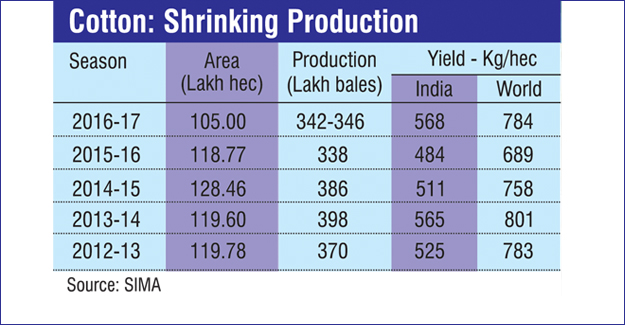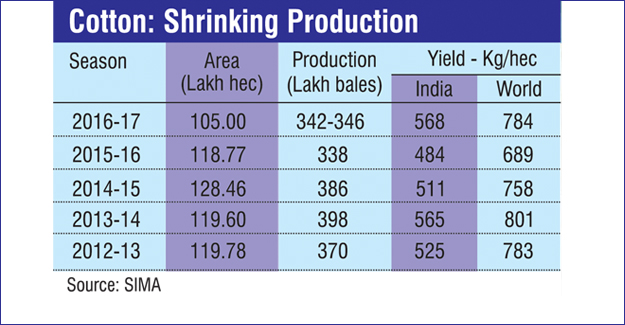
As Cotton Yield Dips, Textile Sector Seeks TMC 2.0
The Indian textile industry believes that cotton has lost its sheen after the closure of the Technology Mission on Cotton (TMC). Despite being acknowledged as the largest producer and net exporter of cotton, Indian productivity dropped below 500 kg of lint/hectare in 2015-16, largely due to pink boll worm infestation, from a high of 566 kg/hec in 2013-14. Productivity during 2016-17 appears to have bounced back to touch a record level of 568 kg/hec and sources attribute this to good monsoon this season as compared to the last. But the production, which stood at 398 lakh bales in 2013-14, has slipped to 342-346 lakh bales in 2016-17.
On the other hand, the national average yield in Australia, Brazil, China, Turkey Mexico and Israel is more than 1,500 kg/hec. India's poor productivity is attributed to obsolete technology and insufficient fund support for cotton research.
"Production might slide below 300 lakh bales in the absence of immediate policy intervention by the government," said M Senthilkumar, Chairman of the Southern India Mills' Association (SIMA). The association has drawn the attention of Union Textile Minister Smriti Irani to the present situation, besides advocating bringing back the TMC in a revised format. A few states have already started advising farmers to avoid cultivation of cotton due to uncertainty in production.
"The existing Bt technology that helped India increase its cotton yield potential expired a few years back. Farmers are suffering due to technology obsolescence," said J Thulasidharan, President, Indian Cotton Federation.
"The Central Institute of Cotton Research (CICR) has developed 21 varieties of desi cotton that yielded excellent results. Farmers who meticulously followed the institute's (cultivation) practices managed to increase their income two-fold. But the scientists could not make further progress due to paucity in fund allocation," he said, reiterating the need for a TMC in a revised format.
"We will need to focus on short duration (140-160 days) varieties and follow best practices that primarily would depend on the local climate, varietal adaptability, soil type and nutrient status, major insects and pests and, of course, market demand. The critical reproductive phase has been compressed in many countries, but India continues to have a long critical window. This should therefore be our first consideration," Thulasidharan said, referring to crop duration.

Textile Excellence
If you wish to Subscribe to Textile Excellence Print Edition, kindly fill in the below form and we shall get back to you with details.








